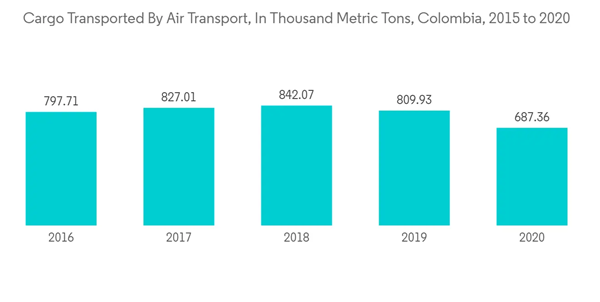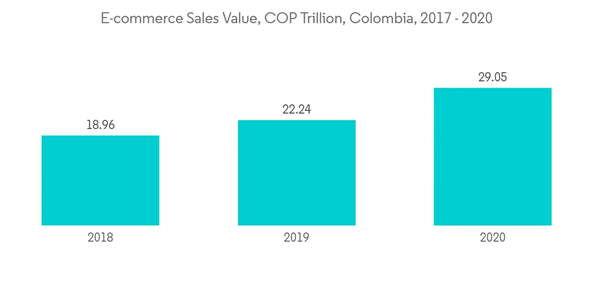The Colombia Freight and Logistics Market size is estimated at USD 20.39 billion in 2024, and is expected to reach USD 29.44 billion by 2029, growing at a CAGR of 7.62% during the forecast period (2024-2029).
After a near-16% GDP drop in the second quarter of 2020 due to the COVID-19 pandemic, the economy began to recover in the third and fourth quarters. Four economic activities in 2020 exhibited positive trends when compared to the previous year's figures. Agriculture grew at a rate of 2.8%, followed by banking and insurance (2.1%), real estate (1.9%), and government administration (1%).
Road freight transport is the dominant mode of transportation in this country. The logistics landscape is becoming more competitive, with international players expanding into the region with strategies such as acquiring local companies. In July 2021, Colombia's COP 749 billion (USD 200 million) Puerta de Hierro-Cruz del Viso corridor was the second project finished under the country's 4G highways program. Several important road projects are now progressing in Colombia. Colombia's national infrastructure agency ANI says that seven of the country's fourth-generation (4G) road projects finished during 2021. A further 10 are expected to be completed during 2022, while one was completed in 2020.
As reported in August 2021, Colombia and the United Kingdom have reached an agreement on GBP 400,000 (about USD 550,000) to promote the revival and strengthen the country's railway operation. The air transport sector is one of the fundamental development engines of the country, which is why the Ministry of Transport has committed itself to strengthen the airport infrastructure with the delivery of fully modernized air terminals. The maintenance of those is required in the case of the Cafe Airport.
Colombia's exports in 2020 were USD 31,056 million, down by 21.4% from the previous year due to the global crisis caused by the coronavirus pandemic. According to the National Department of Statistics (DANE), the main reductions in the year were recorded in foreign oil sales, with a 45.2% drop, falling to USD 8,729 million. According to an industry survey, retailers have turned their stores into small warehouses to respond fast to requests due to a rise in online order volume. In 2021, 78% of logistics and transportation companies made same-day deliveries.
According to data from the Ministry of Transportation, a total of 14,047 flights were flown between March 2021 and August 2021, transporting 276,646 metric tons of cargo on commercial airlines and those dedicated solely to the logistics sector. The statistics show that international freight accounts for 80.8% (223,709 metric tons), while domestic cargo accounts for 19.1% (52,937 metric tons). With mobilized volumes of 220,709 metric tons, 32,017 metric tons, and 5,555 metric tons, respectively, the airports of Bogota, Rionegro, and Barranquilla stand out. During the pandemic, a major portion of the items moved by plane to and from the country was related to medical supplies and priority health units.
Colombia's population has steadily risen over the last two decades, rising from a little over 39 million in 2000 to more than 49 million in 2020. More economic stability and a growing middle class, together with around 60% of Colombians having access to the internet and the influx of new entrepreneurs, have aided in the growth of the country's e-commerce market. In 2020, Colombian e-commerce revenues will total COP 29 trillion (USD 8 billion). When both sales and payments were made online, a 30% increase was observed over the COP 22.2 trillion reported in 2019. E-commerce in Colombia has risen at a weekly rate of 7.84 % since the lockdown began. Between June and July 2020, the most significant rise occurred in the sectors of home, technology, retail, fashion, and beauty.
Colombia is one of Latin America's most appealing economies for international trade and foreign investment. Fuel, wages, and tolls are the highest costs in Colombia, making the country less competitive. However, the condition that seriously affects the country is its complicated geography and the slow development of multimodal infrastructure that is necessary to improve competitiveness in such a rugged environment. For easy and safe transportation of goods, many industrial participants are looking for innovative logistics and supply chain management solutions.
This product will be delivered within 2 business days.
After a near-16% GDP drop in the second quarter of 2020 due to the COVID-19 pandemic, the economy began to recover in the third and fourth quarters. Four economic activities in 2020 exhibited positive trends when compared to the previous year's figures. Agriculture grew at a rate of 2.8%, followed by banking and insurance (2.1%), real estate (1.9%), and government administration (1%).
Road freight transport is the dominant mode of transportation in this country. The logistics landscape is becoming more competitive, with international players expanding into the region with strategies such as acquiring local companies. In July 2021, Colombia's COP 749 billion (USD 200 million) Puerta de Hierro-Cruz del Viso corridor was the second project finished under the country's 4G highways program. Several important road projects are now progressing in Colombia. Colombia's national infrastructure agency ANI says that seven of the country's fourth-generation (4G) road projects finished during 2021. A further 10 are expected to be completed during 2022, while one was completed in 2020.
As reported in August 2021, Colombia and the United Kingdom have reached an agreement on GBP 400,000 (about USD 550,000) to promote the revival and strengthen the country's railway operation. The air transport sector is one of the fundamental development engines of the country, which is why the Ministry of Transport has committed itself to strengthen the airport infrastructure with the delivery of fully modernized air terminals. The maintenance of those is required in the case of the Cafe Airport.
Colombia's exports in 2020 were USD 31,056 million, down by 21.4% from the previous year due to the global crisis caused by the coronavirus pandemic. According to the National Department of Statistics (DANE), the main reductions in the year were recorded in foreign oil sales, with a 45.2% drop, falling to USD 8,729 million. According to an industry survey, retailers have turned their stores into small warehouses to respond fast to requests due to a rise in online order volume. In 2021, 78% of logistics and transportation companies made same-day deliveries.
Colombia Freight & Logistics Market Trends
Growth in Airfreight Volume Driving the Market
Colombia consolidated its fresh take-off to revive its skies and enhance its international connections in 2021, after seven months of aviation immobility due to the pandemic in 2020. This was attributed to the introduction of new operators and the activation of a large number of routes. In the region, the country has become a leader in aviation reactivation. According to the Director of the Aerocivil, 625,000 metric tons of air cargo were handled in the country in the first nine months of 2021, largely through the Bogota airport.According to data from the Ministry of Transportation, a total of 14,047 flights were flown between March 2021 and August 2021, transporting 276,646 metric tons of cargo on commercial airlines and those dedicated solely to the logistics sector. The statistics show that international freight accounts for 80.8% (223,709 metric tons), while domestic cargo accounts for 19.1% (52,937 metric tons). With mobilized volumes of 220,709 metric tons, 32,017 metric tons, and 5,555 metric tons, respectively, the airports of Bogota, Rionegro, and Barranquilla stand out. During the pandemic, a major portion of the items moved by plane to and from the country was related to medical supplies and priority health units.
Growth in E-commerce
The rise of e-commerce will have a direct impact on Colombia's air freight industry's resurrection in 2021. Colombian online sales climbed by 44.3% between January and March 2021, according to the Colombian Chamber of Electronic Commerce. Sales through online channels climbed by 59.4% in 2021 compared to the same period in 2020, totaling USD 9.9 billion. With over 91 million online sales transactions reported in April, May, and June 2021, a remarkable rise over the same quarter in 2019 and 2020, when this figure was 28 and 52 million, respectively, the ongoing expansion of online sales means that more people are opting to purchase online. These rates are projected to climb since events like Cyber Monday and Hot Sale, which held their first annual edition in 2021 and reported sales of over COP 825 billion, have encouraged e-commerce in Colombia.Colombia's population has steadily risen over the last two decades, rising from a little over 39 million in 2000 to more than 49 million in 2020. More economic stability and a growing middle class, together with around 60% of Colombians having access to the internet and the influx of new entrepreneurs, have aided in the growth of the country's e-commerce market. In 2020, Colombian e-commerce revenues will total COP 29 trillion (USD 8 billion). When both sales and payments were made online, a 30% increase was observed over the COP 22.2 trillion reported in 2019. E-commerce in Colombia has risen at a weekly rate of 7.84 % since the lockdown began. Between June and July 2020, the most significant rise occurred in the sectors of home, technology, retail, fashion, and beauty.
Colombia Freight & Logistics Industry Overview
The Colombian freight and logistics sector is highly fragmented, with international and regional businesses competing for business. With both international and regional participants in the market, the Colombian freight and logistics business is becoming more competitive, and vendors are looking for a competitive advantage by constantly adjusting to the changing marketplace. Some of the key players in the market include DHL, Coltanques, Servientrega, Blu Logistics, and Grupo TCC.Colombia is one of Latin America's most appealing economies for international trade and foreign investment. Fuel, wages, and tolls are the highest costs in Colombia, making the country less competitive. However, the condition that seriously affects the country is its complicated geography and the slow development of multimodal infrastructure that is necessary to improve competitiveness in such a rugged environment. For easy and safe transportation of goods, many industrial participants are looking for innovative logistics and supply chain management solutions.
Additional Benefits:
- The market estimate (ME) sheet in Excel format
- 3 months of analyst support
This product will be delivered within 2 business days.
Table of Contents
1 INTRODUCTION
4 MARKET INSIGHTS AND DYNAMICS
5 MARKET SEGMENTATION
6 COMPETITIVE LANDSCAPE
8 APPENDIX
Companies Mentioned (Partial List)
A selection of companies mentioned in this report includes, but is not limited to:
- Deutsche Post DHL Group (including Suppla)
- Coltanques
- FedEx Corporation
- United Parcel Service
- Servicios Postales Nacionales SA
- NAVIERA FLUVIAL COLOMBIANA SA
- SERVIENTREGA SA
- Inter Rapidisimo SA
- Transport Sanchez Polo
- CEVA Logistics
- Agility
- Blu Logistics
- Grupo TCC
- DSV Panalpina*
Methodology

LOADING...










